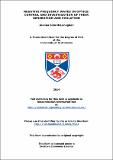Files in this item
Negative frequency waves in optics : control and investigation of their generation and evolution
Item metadata
| dc.contributor.advisor | König, Friedrich | |
| dc.contributor.author | McLenaghan, Joanna Siân | |
| dc.coverage.spatial | 219 | en_US |
| dc.date.accessioned | 2015-04-22T14:06:03Z | |
| dc.date.available | 2015-04-22T14:06:03Z | |
| dc.date.issued | 2014-06-25 | |
| dc.identifier | uk.bl.ethos.644804 | |
| dc.identifier.uri | https://hdl.handle.net/10023/6532 | |
| dc.description.abstract | This thesis is concerned with various methods for the control and investigation of pulse dynamics in a Photonic Crystal Fibre (PCF) and of the radiation driven by a short pulse. In particular the focus is on pulses in the anomalous dispersion region which would form solitons in the absence of higher order effects. Several different types of radiation can be driven by such pulses if they are perturbed by higher order dispersive and non-linear effects - for example Resonant Radiation (RR) and Negative Resonant Radiation (NRR) two dispersive waves which gain energy at the expense of the pulse. The feature of NRR which is of particular importance is that it is the first observed example of a coupling between positive and negative frequencies in optics. This has only been possible due to recent advances in fields such as PCFs, lasers and analogue systems. As with many scientific discoveries, NRR was found by bringing together ideas and techniques from these different fields. Both the pulse and the driven radiation are investigated using a number of different pulse and PCF parameters. These include power, chirp, polarisation and PCF dispersion. These are used to vary the wavelengths at which the driven radiation occurs as well as its generation efficiency. Furthermore the power and chirp are used to vary where in the PCF the driven radiation is generated by controlling where the driving pulse compresses and spectrally expands. This property is used to investigate different stages in the evolution of the pulse and driven radiation as well as to optimise the generation efficiency of the driven radiation. | en_US |
| dc.language.iso | en | en_US |
| dc.publisher | University of St Andrews | |
| dc.rights | Creative Commons Attribution-NonCommercial-NoDerivatives 4.0 International | |
| dc.rights.uri | http://creativecommons.org/licenses/by-nc-nd/4.0/ | |
| dc.subject | Non-linear optics | en_US |
| dc.subject | Photonic crystal fibres | en_US |
| dc.subject | Solitons | en_US |
| dc.subject | Pulse compression | en_US |
| dc.subject | Negative frequencies | en_US |
| dc.subject | Resonant radiation | en_US |
| dc.subject | Analogue Hawking radiation | en_US |
| dc.subject | Pulse chirp | en_US |
| dc.subject | Short pulse dynamics | en_US |
| dc.subject.lcc | QC446.2M6 | en_US |
| dc.subject.lcsh | Nonlinear optics | en_US |
| dc.subject.lcsh | Fiber optics | en_US |
| dc.subject.lcsh | Crystal optics | en_US |
| dc.subject.lcsh | Photonics | en_US |
| dc.subject.lcsh | Solitons | en_US |
| dc.title | Negative frequency waves in optics : control and investigation of their generation and evolution | en_US |
| dc.type | Thesis | en_US |
| dc.contributor.sponsor | Engineering and Physical Sciences Research Council (EPSRC) | en_US |
| dc.type.qualificationlevel | Doctoral | en_US |
| dc.type.qualificationname | PhD Doctor of Philosophy | en_US |
| dc.publisher.institution | The University of St Andrews | en_US |
This item appears in the following Collection(s)
Except where otherwise noted within the work, this item's licence for re-use is described as Creative Commons Attribution-NonCommercial-NoDerivatives 4.0 International
Items in the St Andrews Research Repository are protected by copyright, with all rights reserved, unless otherwise indicated.


